
Early Reading
IN JUNE 2025, 94% OF OUR CHILDREN PASSED THEIR PHONICS SCREENING TEST
IN JUNE 2024, 89% OF OUR CHILDREN PASSED THEIR PHONICS SCREENING TEST
As a school, we teach synthetic phonics as the initial, and most important, approach to the teaching of reading. Our pupils learn to read and write effectively using the Read Write Inc. (RWI) Phonics Programme which is a systematic programme for the teaching of phonics, reading, spelling and writing. We want all pupils to begin their journey to read with confidence, develop a love of reading and apply their skills competently to writing.
We aim to ensure that all pupils:
- Decode letter-sound correspondences quickly and effortlessly, using their phonic knowledge and skills
- Read common exception words e.g. the, a, do, to, on sight
- Understand what they read
- Read aloud with fluency and expression
- Write confidently, with a strong focus on vocabulary and grammar
- Spell quickly and easily by segmenting the sounds in words
- Learn letter formation and handwriting skills
The video below taken from the Ruth Miskin Read Write Inc. website explains the overall scheme in more detail.
Introducing Read Write Inc Phonics in school
We start teaching the programme in our Early Years Foundation Stage (EYFS) and the children then continue until they have worked their way through the whole reading scheme. Usually this is during Year 1 or 2.

In EYFS all children will learn how to ‘read’ and ‘write’ all of the Set 1 sounds and some of Set 2 (see below). They are then taught how to blend these into words. Fred the Frog helps the children to blend the sounds together which are then used to help children read. The teachers will often use the phrase ‘Fred Talk’ to sound out words.
We have ongoing assessments throughout each half term and formally assess all children on the scheme every six to eight weeks, to ensure that they are placed in the correct group for their reading ability. This also allows us to quickly identify any children who needs some support to access the learning at the level of the group. If this arises, we provide one-to-one tutoring for the child in accordance with the Read, Write Inc scheme to help individuals make rapid progress and once again be at the level of their group. Groups are taught by either a teacher or a TA who have had Read, Write Inc Phonics training.
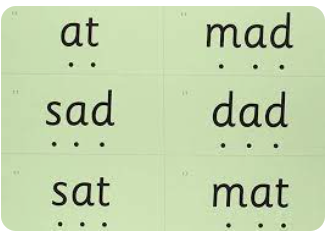
Children begin by learning Set 1 Sounds in a specific order. They also begin learning to blend sounds together to make words after learning the first five sounds, through practising oral blending. When children can blend independently they progress on to reading ‘green words’.
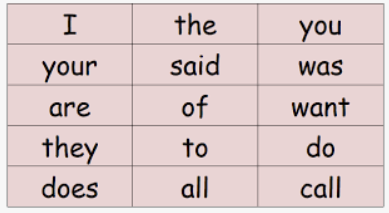
Once children can read ‘green words’ they begin to read stories in their Read, Write Inc sessions. Each storybook is matched to the sounds they can already read, which sets them up for success and helps to build their confidence with reading. It is through the storybooks we teach children ‘red words’, which are irregular words which are not phonetically plausible and cannot be sounded out (Fred Talked). Every storybook is taught in the same way, children practice reading the green words in the story and also the red words before they begin to read the book. Children will then read the book several times to help build their fluency and comprehension skills.
Years 1 and 2
Children follow the same format as EYFS but will work on complex sounds (Set 2 and 3 sounds) and read books appropriate to their reading level. Daily sessions of RWI phonics last for 40 minutes.
Once your child knows all Set 1 Sounds by sight and sound and uses them to blend to read words, we start teaching Set 2 sounds initially and then Set 3 Long Vowel Sounds. Your child will need to learn that most vowel sounds have more than one spelling. There are twelve Set 2 ‘Speed Sounds’ which are made up of two or three letter which represent just one sound. For example, ay as in play, ee as in tree and igh as in high. It is important that your child does not pronounce these as two or three separate sounds. When you child sees the ‘speed sound’ letters together in a word, they must say just one sound for these letters.
Set 1 Sounds are taught in the following order, together with rhymes to help children form the letters correctly and instantly recognise sounds ready for blending:
|
Set 1 Sounds
|
|
|
Sound |
Rhyme |
|
m |
Down Maisie then over the two mountains. Maisie, mountain, mountain. |
|
a |
Round the apple, down the leaf. |
|
s |
Slide around the snake |
|
d |
Round the dinosaur's back, up his neck and down to his feet. |
|
t |
Down the tower, across the tower, |
|
i |
Down the insect’s body, dot for the head. |
|
n |
Down Nobby and over the net. |
|
p |
Down the plait, up and over the pirate’s face. |
|
g |
Round the girl’s face, down her hair and give her a curl |
|
o |
All around the orange |
|
c |
Curl around the caterpillar |
|
k |
Down the kangaroo’s body, tail and leg |
|
u |
Down and under the umbrella, up to the top and down to the puddle |
|
b |
Down the laces, over the toe and touch the heel |
|
f |
Down the stem and draw the leaves |
|
e |
Slice into the egg, go over the top, then under the egg |
|
l |
Down the long leg |
|
h |
Down the horse's head to the hooves and over his back |
|
sh |
Slither down the snake, then down the horse's head to the hooves and over his back |
|
r |
Down the robot's back, then up and curl |
|
j |
Down his body, curl and dot |
|
v |
Down a wing, up a wing |
|
y |
Down a horn, up a horn and under the yak's head. |
|
w |
Down, up, down, up the worm. |
|
th |
Down the tower, across the tower, then down the horse’s head to the hooves and over his back |
|
z |
Zig-zag-zig, down the zip. |
|
ch |
Curl around the caterpillar, then down the horse's head to the hooves and over his back |
|
qu |
Round the queen’s head, up to her crown, down her hair and curl |
|
x |
Cross down the arm and leg and cross the other way |
|
ng |
A thing on a string |
|
nk |
I think I stink |
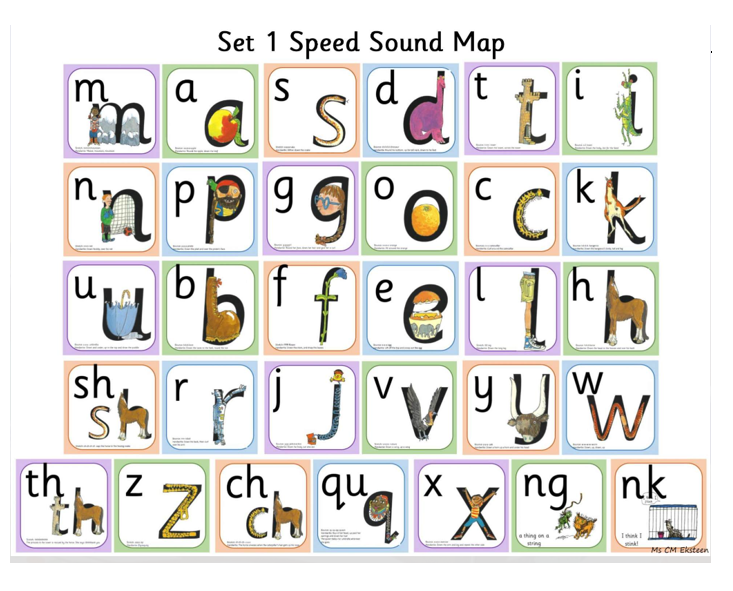
Set 2 and 3 Sounds
Set 2 Sounds - the Long Vowels. When children are very confident with both Set 1 and Set 2 Sounds, they are taught Set 3 Sounds.
|
|
|
|
|
|
Long Vowel sound |
Set 2 Sounds |
Set 3 Sounds |
|
|
ay |
ay: may I play |
a-e: make a cake |
ai: snail in the rain |
|
ee |
ee: what can you see |
ea: cup of tea |
e: he me we she be |
|
igh |
igh: fly high |
i-e: nice smile |
|
|
ow |
ow: blow the snow |
o-e: phone home |
ao: goat in a boat |
|
oo |
oo: poo at the zoo |
u-e: huge brute |
ew: chew the stew |
|
oo |
oo: look at a book |
|
|
|
ar |
ar: start the car |
|
|
|
or |
or: shut the door |
aw: yawn at dawn |
|
|
air |
air: that’s not fair |
are: share and care |
|
|
ir |
ir: whirl and twirl |
ur: nurse for a purse |
er: a better letter |
|
ou |
ou: shout it out! |
ow: brown cow |
|
|
oy |
oy: toy for a boy |
oi: spoil the boy |
|
|
ire |
|
ire: fire fire! |
|
|
ear |
|
ear: hear with your ear |
|
|
ure |
|
ure: sure it’s pure? |
|
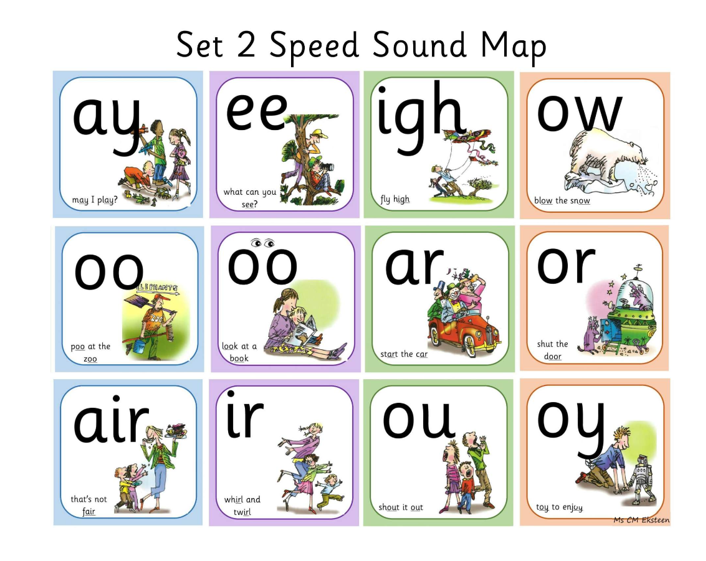
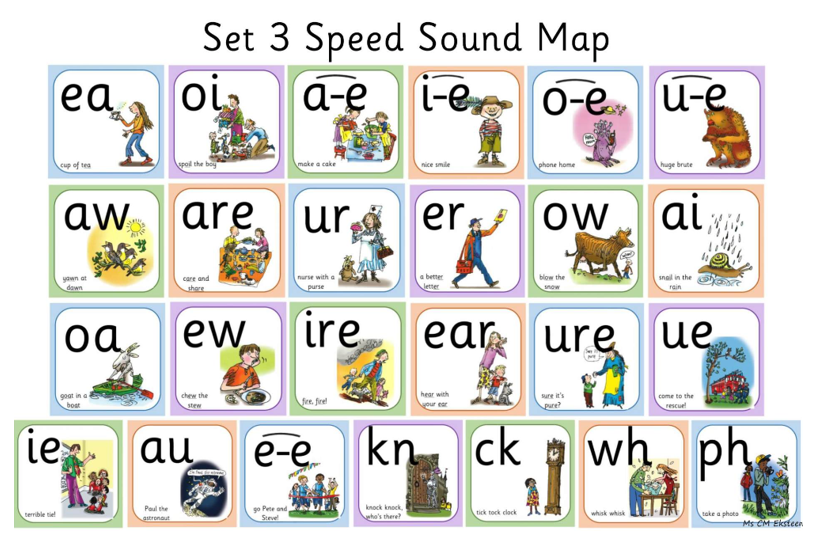
Seesaw link to Set 1 Special Friends
Blending (Fred Talk)
To expose your child to the idea of blending sounds together to make words, break down the words of the simple vocabulary you often use at home. For example, “please pass me that c – u – p”, “time for b – e - d”. This will help your child to practise their own oral blending as they can repeat the sounds back to you and then say the word. Help your child to say the pure sounds (‘m’ not ‘muh’, ‘s’ not ‘suh’ etc) as quickly as they can and then blend the sounds together to say the whole word.
The video below taken from the Ruth Miskin Read Write Inc. website explains HOW to blend in more detail.
Reading
When using Read, Write Inc to read the children will:
- Learn 44 sounds and the corresponding letter/letter groups using simple prompts
- Learn to read words using sound blending (Fred Talk)
- Read lively stories featuring words they have learnt to sounds out
- Show that they comprehend the stories by answering ‘Find It’ and ‘Prove It’
Writing
When using Read, Write Inc to write the children will:
- Learn to write the letter/letter groups which represent the 44 sounds
- Learn to write words by saying the sounds and graphemes (Fred Fingers)
Talking
When using Read, Write Inc the children will also work in pairs:
- To answer questions
- To take turns talking and listening to each other
- To give positive praise to each other
Reading With Your Child
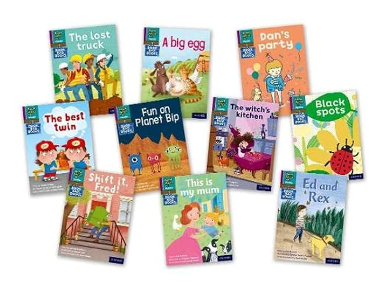
Your child will bring home reading books (RWI Book Bag Books) which are precisely pitched at your child’s reading level, to share with you. It is important you listen to them read each day. Help your child to decode words at home, it is really important to pronounce the sounds correctly. (There are links useful videos within this document.)
Your child will also be allocated RWI Ebooks on Oxford Owls and can access these with their username and password at home.
Your child also has unlimited access to school library books which can be borrowed from each classroom’s Library Book Basket.
Vocabulary Building
Children need a rich vocabulary in order to develop high levels of comprehension. Help your child to build a wider vocabulary by using alternative words for things at home. Rather than saying you are pleased that they have tidied their toys away, you could use delighted, overjoyed, or thrilled. Again you can use massive, huge, enormous if you are describing something big.
Finally Do Not Worry!
If your child is struggling at first with their sounds and words, do not worry. They will get there in their own time. If you have time (and we all know time is precious!), try and read stories to your child before they go to bed. This will not only help develop a wider vocabulary which makes a vast difference to their quality of writing but it will also encourage them to enjoy a good story.
Please find at table below which highlights some of the keys phrases school uses when teaching RWI.
|
Term |
Definition |
|
Fred |
Fred is a frog puppet we use in sessions. He can only speak in sounds. |
|
Fred Talk |
Sounding out a word, saying each of the sounds before blending |
|
Fred Fingers |
‘Pinching’ each sound from a word on your fingers to help spell a word |
|
Green Words |
Decodable words |
|
Red Words |
Irregular words which cannot be sounded out |
|
Story Green Words |
Decodable words which will be included in the storybook |
|
Speedy Green Words |
Decodable words in the storybook which children should be able to read at speed rather than Fred Talking first. |
|
Fred in your Head |
Still sounding out a word but doing so in your head rather than out loud, to help build fluency. |
|
Special Friends |
Two or three letters working together to make one sound e.g. sh, ch, igh, air, a-e, i-e. |
Useful Resources
Oxford Owl - https://home.oxfordowl.co.uk/
Ruth Miskin website - https://home.oxfordowl.co.uk/reading/reading-schemes-oxford-levels/read-write-inc-phonics-guide/
Ruth Miskin website- https://www.ruthmiskin.com/en/parents-copy-2/

